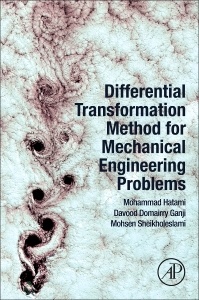Differential Transformation Method for Mechanical Engineering Problems
Auteurs : Hatami Mohammad, Ganji Davood Domairry, Sheikholeslami Mohsen

Differential Transformation Method for Mechanical Engineering Problems focuses on applying DTM to a range of mechanical engineering applications. The authors modify traditional DTM to produce two additional methods, multi-step differential transformation method (Ms-DTM) and the hybrid differential transformation method and finite difference method (Hybrid DTM-FDM).
It is then demonstrated how these can be a suitable series solution for engineering and physical problems, such as the motion of a spherical particle, nanofluid flow and heat transfer, and micropolar fluid flow and heat transfer.
1. Introduction to Differential Transformation Method2. Differential Transformation Method in Advance3. DTM for Heat Transfer Problems4. DTM for Fluids Flow Analysis5. DTM for Nanofluids and Nanostructures Modeling6. DTM for Magnetohydrodynamic (MHD) and Porous Medium Flows7. DTM for Particles Motion, Sedimentation, and Combustion8. DTM for Solid Mechanics, Vibration, and Deflection
PG students and researchers in fluid dynamics and heat transfer.
D. D. Ganji is a Professor of Mechanical Engineering and the Director of the Graduate Program at Babol Noshirvani University of Technology in Iran, as well as a consultant in nonlinear dynamics and the Dean of the National Elite Foundation of Iran. He has a Ph.D. in Mechanical Engineering from Tarbiat Modarres University. He is the Editor-in-Chief of International Journal of Nonlinear Dynamic and Engineering Science, and Editor of International Journal of Nonlinear Sciences and Numerical Simulation and International Journal of Differential Equations.
Dr. Mohsen Sheikholeslami is an Associate Professor in the Department of Mechanical Engineering, at Babol Noshirvani University of Technology, Babol, Iran, where he is also Head of renewable energy systems and nanofluid applications in the Heat Transfer Laboratory. Dr. Sheikholeslami’s re
- Presents the differential transformation method and why it holds an advantage over higher-order Taylor series methods
- Includes a full mathematical introduction to DTM, Ms-DTM, and Hybrid DTM
- Covers the use of these methods for solving a range of problems in areas such as nanofluid flow, heat transfer, and motion of a spherical particle in different conditions
- Provides numerous examples and exercises which will help the reader fully grasp the practical applications of these new methods
Date de parution : 11-2016
Ouvrage de 422 p.
15x22.8 cm
Thèmes de Differential Transformation Method for Mechanical... :
Mots-clés :
Cantilever beam; Carbon nanotube; Combustion of particles; Composite; Couette fluid; Couette nanofluid; Deflection; Differential transformation method (DTM)DTM-Pad�Hybrid DTM-FDM; Divergent/convergent channels; Eigenvalue problems; Falkner�Skan wedge flow; FGM beams; Fins; Fractional differential transform method; Free convection; Integro-differential equation; Magnetohydrodynamic; MDTM; MHD viscous; Micropolar fluid; Ms-DTM; Nanobeam; Nanofluid; Natural convection; Non-Newtonian fluid; Nonspherical particles; Oscillators; Particle sedimentation; Piezoelectric; Porous channel; Porous surfaces; RDTM; Rectangular plate; Soluble particle; Spherical particle; Stiffened beam; Thermal boundary layer; Two-dimensional DTM; Vibration; Viscoelastic; Viscous flow



